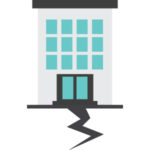
An earthquake causes the earth’s crust to shake in a range of slight tremors to large shocks. St. Louis is in the New Madrid Seismic Zone, which has experienced three of the largest earthquakes in the United States. A major earthquake in the St. Louis region has the potential to cause widespread damage in multiple states.
Because a New Madrid Seismic Zone earthquake cannot be predicted, it is important to take steps to learn about earthquakes and to protect yourself.
How to prepare before it happens
Prepare for an earthquake by taking a few minutes to identify safe spots and potential danger zones in your area such as:
- Top-heavy, free-standing items that could topple.
- Heavy or breakable items on high shelves.
- Heavy items hung on the wall or ceiling near the work area.
What to do when it happens
If you are inside:
- Stay put and DROP. Take COVER under a sturdy piece of furniture.
- HOLD ON until the shaking stops.
- After the shaking stops, if the building is unsafe, gather outside at your Emergency Assembly Point. If you hear a hissing sound, or smell gas, leave the building.
- Use the stairs rather than an elevator.
If you are outside:
- Avoid trees, power lines and other overhead hazards.
- Move to an open area, if possible.
- Drop to the ground until the shaking stops.
If you are in a vehicle:
- Pull over and stop your car.
- Do not stop on overpasses or underpasses or bridges.
- Stay in the vehicle until the shaking stops.
What to do right after it happens
- Check yourself and others in your area for injuries.
- Be prepared for aftershocks. Each time one occurs, DROP, COVER and HOLD ON.
- Monitor local radio, television, social media or emergency.wustl.edu to get news and instructions.